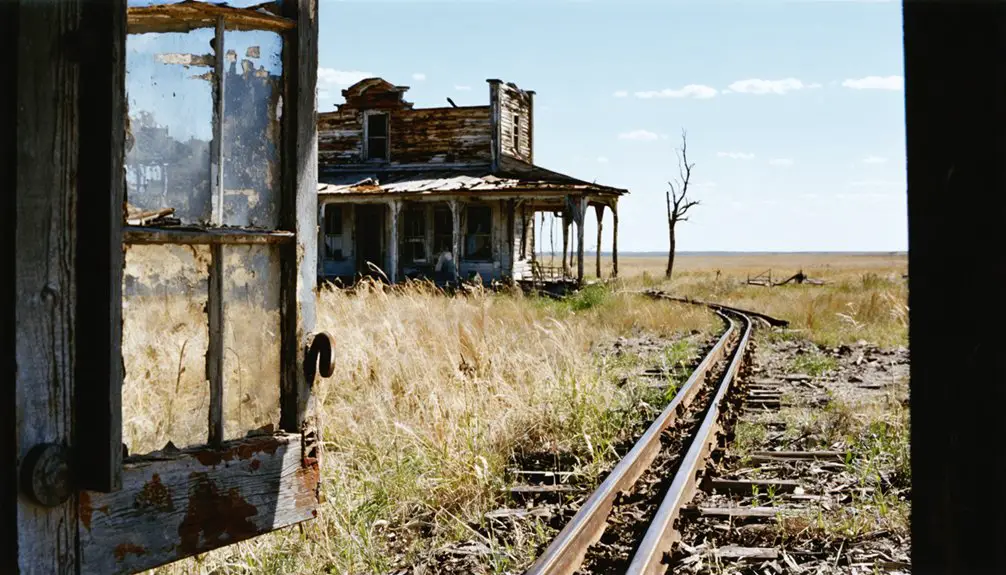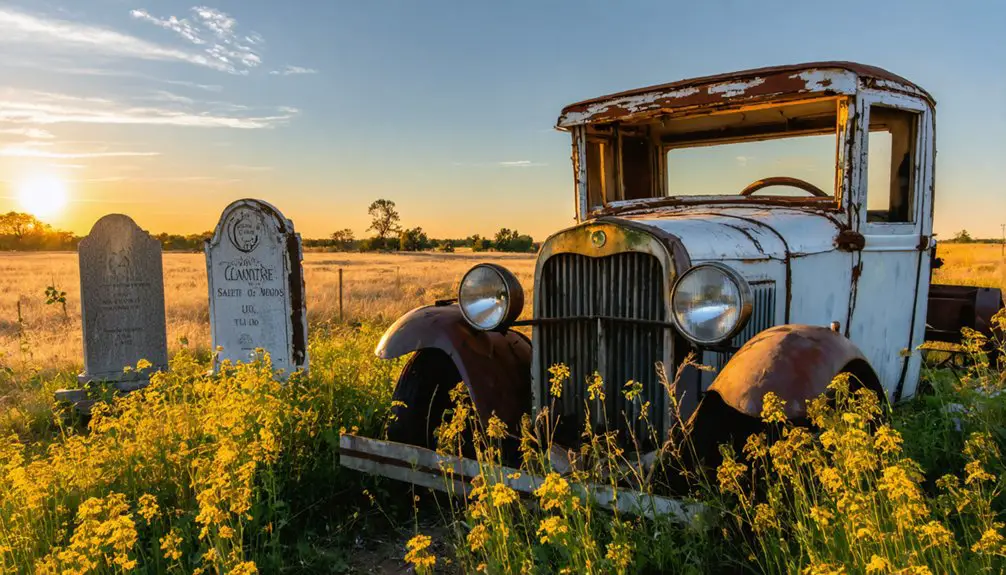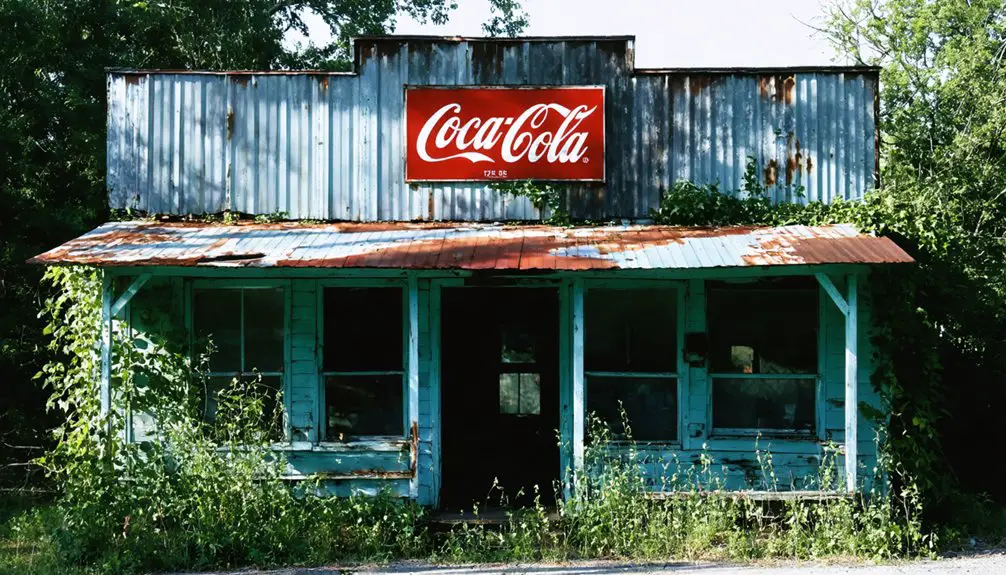You’ll find Coles Settlement, one of Texas’s earliest ghost towns, in Washington County where it was established in 1824 by John P. Coles during Stephen F. Austin’s Old Three Hundred colonization. Once a wealthy pioneer community and home to Baylor University, the settlement declined after local leaders rejected the Santa Fe Railroad’s right-of-way request in the 1880s. While most residents left, the town’s rich heritage lives on through preserved 19th-century structures and historic landmarks that tell a fascinating tale of early Texas life.
Key Takeaways
- Coles Settlement was established in 1824 by John P. Coles as part of Stephen F. Austin’s Old Three Hundred colonists in Washington County.
- The settlement became one of Texas’s wealthiest communities, featuring Baylor University as the state’s first institution of higher learning.
- The town’s decline began when leaders rejected the Santa Fe Railroad’s right-of-way access, isolating the settlement from vital trade routes.
- After Baylor University relocated to Waco in 1885, the population drastically decreased, leading to the post office’s closure by 1966.
- Historic structures, including the John P. Coles House and Old Baylor ruins, remain as preserved remnants of this once-thriving Texas community.
The Birth of a Texas Pioneer Settlement
When Stephen F. Austin’s Old Three Hundred colonists ventured into Texas, John P. Coles established what you’d know as Coles Settlement in 1824.
You’ll find its origins deeply rooted in Mexican land grants, where pioneer challenges shaped the determination of early settlers breaking ground in what would become Washington County.
As you explore the settlement’s birth, you’ll discover how Coles and fellow pioneers transformed untamed wilderness into productive farmland through agricultural innovations.
Just as the early Kentucky pioneers had done in Charleston Township, they strategically positioned their community near essential waterways, establishing trading posts and communal buildings that served the growing population.
They strategically positioned their community near essential waterways, establishing trading posts and communal buildings that served the growing population.
The settlement’s strategic location helped overcome the isolation that many frontier communities faced, while the purchase of multiple adjoining tracts allowed for expanded farming and ranching operations that would sustain generations of Texas settlers. Dr. John Cole and his family would later follow a similar pioneering path when establishing their own settlement in Nacogdoches County in 1843.
Early Life Under Mexican Rule
Life under Mexican rule brought significant changes to Coles Settlement as the young nation of Mexico sought to assert control over its vast northern territory.
Mexico’s efforts to control its northern frontier transformed life in Coles Settlement, marking a period of significant territorial changes.
You’d find that Mexican governance remained relatively loose due to the settlement’s remote location, allowing settlers considerable autonomy in their daily affairs. While Mexico officially required conversion to Catholicism, Spanish language adoption, and loyalty pledges, these rules weren’t strictly enforced in frontier communities like Coles Settlement.
The empresario system that brought settlers here reflected Mexico’s strategy to populate Texas, but it also created unexpected challenges as Anglo-American colonists maintained their cultural ties to the United States. This situation became more complex when Mexico shifted from a federal to centralist government in 1834. The government’s plan to attract settlers included offering land grants to empresarios who would recruit families to the region.
Despite being Mexican citizens, you’d see most settlers continuing their familiar practices, largely disregarding official Mexican policies on issues like slavery and trade restrictions.
The Rise to Regional Prominence
As John P. Coles’s settlement evolved, you’d have witnessed its remarkable transformation into one of Texas’s wealthiest communities.
The town’s community development accelerated after gaining local governance status in 1828, when Mexican authorities appointed Coles as alcalde of Washington Municipality. The location was originally established when Coles arrived in 1822 with Stephen F. Austin’s pioneering colonists.
The town’s rich history is preserved through its 19th century homes that still stand today, offering visitors a glimpse into its prosperous past.
Educational Legacy and Cultural Growth
You’ll find Independence’s most enduring contribution to Texas education in Baylor University’s original campus, which opened its doors in 1846 as the state’s first institution of higher learning.
While serving as a vibrant cultural center, Baylor’s presence attracted scholars and students who transformed this former Coles Settlement into a regional hub of intellectual activity.
Like the devastating hurricanes that destroyed Indianola, natural disasters played a significant role in shaping Texas ghost towns.
The four columns still stand today as a testament to the former university’s main building.
The university’s eventual relocation, prompted by the railroad’s bypass of Independence, marked the end of the town’s golden age as an educational epicenter, though its pioneering role in Texas higher education remains preserved at Old Baylor Park.
Baylor’s Pioneering Campus
The educational legacy of Baylor University began in 1841 when Robert E.B. Baylor, James Huckins, and William Milton Tryon established Texas’s first university through the Texas Union Baptist Association.
You’ll find Baylor’s beginnings were modest but pioneering – the original campus opened in Independence, Texas in 1846, granting its first degree in 1854.
The academic evolution saw dramatic changes under presidents Henry Lee Graves and Rufus C. Burleson, who organized formal coursework and expanded beyond ministerial training. Today’s modern campus spans 1,000 acres in Waco.
While initially coeducational, the campus split in 1851 when Burleson separated male and female students between Windmill Hill and Academy Hill. The female department later became the separate University of Mary Hardin-Baylor.
This arrangement lasted until 1886, when the university consolidated with Waco University and permanently relocated to Waco, ushering in a new era of growth.
Cultural Hub Before Decline
Independence’s rise as a cultural center paralleled Baylor University’s early growth, transforming from a modest settlement into a vibrant educational hub by the 1850s.
You’ll find that the community dynamics flourished with the establishment of essential institutions, including a hotel, stagecoach depot, jail, and Masonic lodge. The town’s social evolution accelerated after its 1852 incorporation under Mayor T. T. Clay’s leadership.
Religious institutions shaped the town’s character, with the Union Baptist Association and Independence Baptist Church serving as cultural anchors.
The presence of Baylor University and Baylor Female College drew students from across the region.
However, the town’s refusal to grant railroad right-of-way to Santa Fe would later prove devastating, triggering an exodus of both educational institutions and economic significance.
The Railroad Decision That Changed Everything

When you examine the decline of Coles Settlement in Washington County, Texas, you’ll find that its fate was sealed by railroad companies’ decisions to bypass the town entirely.
Your understanding of this pivotal moment must account for how surrounding communities with railroad stops siphoned away trade and population, leaving Independence without essential economic connections to larger markets.
You can trace the town’s rapid decline directly to this railroad exclusion, which ultimately prompted even Baylor University to relocate, transforming a once-thriving settlement into a quiet rural community.
Railroad Bypass Impact
During the pivotal 1880s, a fateful decision by Independence’s city leaders and Baylor administrators to deny Santa Fe Railroad‘s right-of-way access transformed the town’s destiny.
The railroad politics that followed reshaped the region, as competing towns like Brenham and Giddings secured rail connections and flourished while Independence faced settlement decline.
- Baylor University and Baylor Female College relocated in 1885, with the university moving to Waco and the female college to Belton
- The town’s population plummeted to around 200 by 1966, leading to the closure of its post office
- Rail-connected towns gained county seats and infrastructure, while Independence lost its economic and political prominence
You’ll find that this once-wealthy community’s refusal of railroad access effectively sealed its fate, reducing it to a rural settlement with only historic sites remaining as evidence of its former glory.
Economic Lifeline Cut Off
The prosperous economic foundation of Coles Settlement rested heavily on its position as a transportation and trade hub by the mid-19th century, with local commerce flourishing around Baylor University’s 1846 establishment.
You’d have witnessed a dramatic shift in the town’s fortunes when local leaders rejected the Santa Fe railroad’s request for right-of-way. This fateful decision severed essential transportation infrastructure links that could have sustained the settlement’s economic vitality.
While neighboring towns embraced rail connections and thrived, Coles Settlement faced increasing economic isolation. Without competitive market access, local businesses and farmers couldn’t reach broader markets efficiently.
The impact was devastating – Baylor University relocated to Waco in 1885, trade diverted to rail-connected towns, and the once-wealthy community’s commercial district contracted, transforming into a small rural settlement.
Notable Citizens and Historic Landmarks
Founded by John P. Coles in 1824, this settlement became home to several notable citizens including Sam Houston, who lived there from 1853 to 1858.
You’ll find historic landmarks scattered throughout the area, particularly the John P. Coles House – the oldest surviving structure in Washington County. The town’s educational heritage centers on the Old Baylor University campus, established in 1846.
- The Houston-Lea Family Cemetery contains Margaret Houston’s remains, while the Old Independence Cemetery holds Sam Houston Jr. and Moses Austin Bryan.
- The original Baylor campus ruins stand as a symbol to the town’s role in Texas education.
- Historic Hairston-McKnight Homestead features a preserved stone kitchen, offering glimpses into early settler life.
What remains today tells a compelling story of Texas independence and pioneer spirit.
Preserving Texas Heritage Today

While historic landmarks and notable citizens shaped Coles Settlement’s past, modern preservation efforts now work to safeguard its legacy for future generations.
You’ll find that heritage preservation in Texas ghost towns like Coles Settlement now benefits from statewide initiatives and local support through county historical commissions. These commissions play a crucial role in community engagement, helping survey sites, maintain markers, and promote tourism in areas that lack formal infrastructure.
You can see how adaptive reuse projects are breathing new life into historic structures while preserving their cultural significance.
Though challenges like decaying infrastructure and geographic isolation persist, low property costs and existing utility rights-of-way provide opportunities for sustainable preservation.
Together with the Texas Historical Commission, local groups continue protecting authentic places that tell Texas’s real stories.
Frequently Asked Questions
What Was the Average Land Price in Coles Settlement During the 1830S?
You’d find land values around $0.50 per acre in this area, as economic factors like Republic of Texas settlement policies kept prices intentionally low to attract pioneers seeking independence.
How Many Stagecoach Routes Connected Independence to Other Texas Settlements?
You’d be amazed that while Texas boasted 31 stagecoach travel routes statewide, Independence specifically maintained 2-5 historical routes connecting to regional hubs like Brenham, LaGrange, and settlements along the Brazos River.
What Indigenous Tribes Lived in the Area Before Coles Settlement?
You’d have found the Caddo Confederacy as primary inhabitants, with Cherokee, Shawnee, and Delaware tribes later moving through the area, establishing their Native Tribes’ Cultural Heritage before being forcibly displaced.
How Many Slaves Worked in Independence During Its Peak Prosperity?
You’ll find that Independence’s slave population reached several hundred during its peak prosperity in the 1850s, with enslaved people making up 25-35% of the area’s residents and driving the region’s economic impact.
What Crops Were Primarily Grown by Early Settlers in Independence?
You’ll find early Independence settlers focused heavily on corn farming and cotton cultivation, while also growing wheat, beans, and potatoes to sustain their families and generate income through agricultural trade.
References
- https://www.hmdb.org/m.asp?m=156743
- https://www.ctpost.com/news/slideshow/Ghost-towns-around-Texas-95681.php
- https://www.co.washington.tx.us/page/washington.independence
- https://en.wikipedia.org/wiki/List_of_ghost_towns_in_Texas
- https://www.hmdb.org/m.asp?m=157275
- https://www.tshaonline.org/handbook/entries/independence-tx-washington-county
- https://www.ghosttowns.com/states/tx/independence.html
- https://www.tshaonline.org/handbook/entries/coles-john-p
- https://www.texasescapes.com/TOWNS/Independence/IndependenceTexas.htm
- https://www.forttumbleweed.net/independence.html



